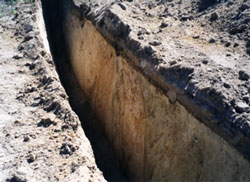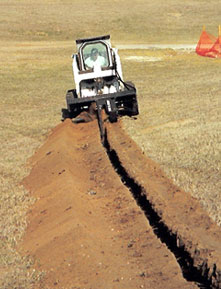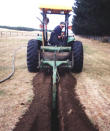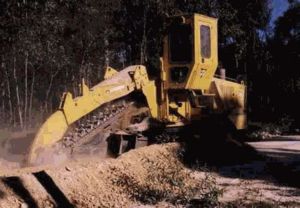
Installation Information
Trenching for Conduit/Conductors
 Assessing trenching costs for electrical/telco conduit and conductor runs is one of the more difficult areas to estimate since you’re not always aware of what surprise underground encounters you’ll have, from an outcropping of rock to an unrecorded utility line. Even seasoned estimators are uncertain as to the accuracy of their earthwork numbers, especially if they haven’t been provided with enough site and soil information. Assessing trenching costs for electrical/telco conduit and conductor runs is one of the more difficult areas to estimate since you’re not always aware of what surprise underground encounters you’ll have, from an outcropping of rock to an unrecorded utility line. Even seasoned estimators are uncertain as to the accuracy of their earthwork numbers, especially if they haven’t been provided with enough site and soil information.
Soil borings are typically taken at the tower base and are fine for estimating soil conditions for electrical trenching requirements in  the compound, but extended runs to the utility demarcation can be anybody’s guess. Many rural sites can require runs up to 2,500’ or more. the compound, but extended runs to the utility demarcation can be anybody’s guess. Many rural sites can require runs up to 2,500’ or more.
If you’re excavating on a greenfield site, chain trenchers can accomplish a lot in a short time and will adapt to most soil conditions, but they are impractical on small jobs. A colocation will often require considerable hand digging to avoid neighboring tenant grounding and electrical  systems. The best choice in equipment depends upon soil conditions, size of the trench, and the amount of work necessary. There's no single piece of equipment that fits every job. One might require a rock crushing trencher, others can be easily handled with a walk behind chain trencher. Backhoes are the industry standard for deeper and wider trenches. systems. The best choice in equipment depends upon soil conditions, size of the trench, and the amount of work necessary. There's no single piece of equipment that fits every job. One might require a rock crushing trencher, others can be easily handled with a walk behind chain trencher. Backhoes are the industry standard for deeper and wider trenches.
There will always be hand excavation requirements to provide working areas for pull boxes and other site requirements.
 Trenching width and depth requirements can vary based upon client and code requirements. The default pricing of $6.85 per linear foot (under 50') is average subcontractor pricing offered for excavating, backfilling and compacting a 24”x36” trench based Trenching width and depth requirements can vary based upon client and code requirements. The default pricing of $6.85 per linear foot (under 50') is average subcontractor pricing offered for excavating, backfilling and compacting a 24”x36” trench based  upon normal soil conditions. Use $4.70 per foot if the trench is 10”x36”. It does not include conduit or conductor placement. Extended runs will be priced according to the linear feet entered. Add to your pricing the cost to remove any rock or excess spoils and concrete cutting expenses as well as borings, if required. This per linear foot pricing is not as reliable as your own cost data on work done by your crews, with your equipment and under conditions you know and understand. Track each job carefully so that you can quote your projects more profitably. upon normal soil conditions. Use $4.70 per foot if the trench is 10”x36”. It does not include conduit or conductor placement. Extended runs will be priced according to the linear feet entered. Add to your pricing the cost to remove any rock or excess spoils and concrete cutting expenses as well as borings, if required. This per linear foot pricing is not as reliable as your own cost data on work done by your crews, with your equipment and under conditions you know and understand. Track each job carefully so that you can quote your projects more profitably.
Local excavators can assist
 Sometimes the easiest way to handle trenching and excavation is to get a firm quote from a dirt contractor. They can be very competitive and knowledgeable of the soil conditions and the equipment that will be required. Even if you have a good relationship with a local excavator, obtain additional bids occasionally to ensure that you ar e receiving a competitive proposal, especially when the sub surface has a considerable amount of rock. Sometimes the easiest way to handle trenching and excavation is to get a firm quote from a dirt contractor. They can be very competitive and knowledgeable of the soil conditions and the equipment that will be required. Even if you have a good relationship with a local excavator, obtain additional bids occasionally to ensure that you ar e receiving a competitive proposal, especially when the sub surface has a considerable amount of rock.
Many electrical contractors have their own trenching equipment and routinely do most of their own excavation. Others rent what's needed on a job by job basis. A good rule of thumb is to only purchase trenching equipment if you are going to be using it at least two weeks out of each month.
We recommend that you contact our listed electrical installation contractors to obtain additional information about their trenching services, capabilities and experience or view our site development contractor listings.
|